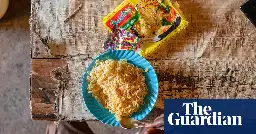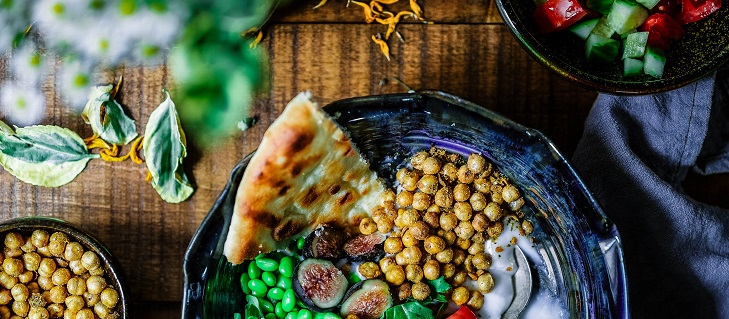
Science of Cooking
- Sauerkraut cannot be cooked or frozen if you want the probiotics it offers
Since sauerkraut is fermented it contains probiotics to add to your beneficial gut bacteria (#microflora). I grew up eating the stuff, but never got that benefit because it was always cooked at high temps in an oven. That classic pork roast in sauerkraut is a typical New Year’s dish.
Cooked sauerkraut is prebiotic (with an E), which feeds the microflora.
So what I am tempted to conclude is that the pork roast should cook in some sauerkraut (for flavor and for the prebiotics. But before serving some cold or room temp uncooked sauerkraut should be mixed in to increase gut bacteria.
Do folks agree or disagree with this?
Unlike kimchi, sauerkraut is much better cooked because uncooked is strong and acidic. So I’m trying to get the best of both worlds. There must be a temp at which sauerkraut can brought to without compromising the microflora. What temp is it, though?
- We need more Native American restaurants | Food and Environment Reporting Networkthefern.org We need more Native American restaurants | Food and Environment Reporting Network
If you stop at a roadside restaurant anywhere between North Dakota and Oklahoma, you might not immediately get a sense of culinary diversity. Many menus in rural and small-town middle America consist…

- The Fight to Save Chile's Glorious White Strawberrywww.atlasobscura.com The Fight to Save Chile's Glorious White Strawberry
The ancestor of the big red strawberry is in peril.
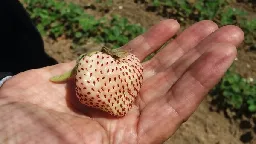
- The world gets more seafood from aquaculture than wild catchourworldindata.org The world gets more seafood from aquaculture than wild catch
There are two ways to produce seafood: catch fish in the wild or farm your own. Seafood farming is often called “aquaculture”. Aquaculture is dominated by the farming of fish, but also includes other organisms, such as crustaceans and aquatic plants.
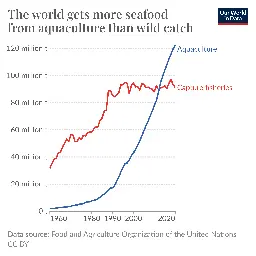
- Uh-Oh: A story of SpaghettiOs and forgotten historysnackstack.net Uh-Oh: A story of SpaghettiOs and forgotten history
In which a pasta-filled rabbit hole leads to an unexpected place

- Iridescence in Meat Caused by Surface Gratingswww.mdpi.com Iridescence in Meat Caused by Surface Gratings
The photonic structure of cut muscle tissues reveals that the well-ordered gratings diffract light, producing iridescent colours. Cut fibrils protruding from the muscle surface create a two-dimensional periodic array, which diffract light at specific wavelengths upon illumination. However, this pho...

- Big Milk has taken over American schoolswww.vox.com Big Milk has taken over American schools
How centuries of milk marketing warped the way we think about dairy and nutrition.

- Is Red Meat Healthy? Multiverse Analysis Has Lessons Beyond Meatwww.medscape.com Is Red Meat Healthy? Multiverse Analysis Has Lessons Beyond Meat
Is red meat bad for you? A multiverse analysis shows that the answer varies by analytic method. The takeaway beyond meat is that this approach should be used for most observational research.

- Yerba mate: South America’s Indigenous tea, from Paraguay to Syriaglobalvoices.org Yerba mate: South America’s Indigenous tea, from Paraguay to Syria
A popular saying in Argentina has it that “a mate is denied to no one”

- Saffron: The Story of the World’s Most Expensive Spice - JSTOR Dailydaily.jstor.org Saffron: The Story of the World’s Most Expensive Spice - JSTOR Daily
Appearing in the written record as early as 2300 BCE, saffron can be traced in foodways around the globe, despite the finicky nature of its harvest.

- African cocoa plants run out of beans as global chocolate crisis deepens | Reuters News Agencywww.reutersagency.com African cocoa plants run out of beans as global chocolate crisis deepens | Reuters News Agency
Reuters exclusively reported that major African cocoa plants in Ivory Coast and Ghana have stopped or cut processing because they cannot afford to buy
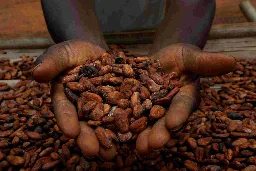
- It’s Hearty, It’s Meaty, It’s Moldnewscenter.lbl.gov It’s Hearty, It’s Meaty, It’s Mold
Did you know fungi naturally produce all the ingredients needed for a cruelty-free meat substitute? Our scientists are exploring how tuning the genomes of mushrooms and molds can transform these food sources into gourmet, nutrient-packed meals made with minimal processing and a light environmental f...

- PFAS 'forever chemicals' to officially be removed from food packaging, FDA sayswww.livescience.com PFAS 'forever chemicals' to officially be removed from food packaging, FDA says
New food packaging products sold in the U.S., such as takeout boxes and fast-food wrappers, will no longer contain harmful "forever chemicals" known as PFAS.

- Combating Olive Oil Fraud with Nuclear Innovationswww.iaea.org Combating Olive Oil Fraud with Nuclear Innovations
The International Atomic Energy Agency (IAEA) is developing new and rapid methods to rapidly screen and authenticate the origin of foods like extra virgin olive oil.
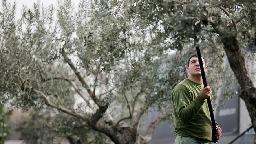
- The Boy Who Was King of Vanillanautil.us The Boy Who Was King of Vanilla
His brilliant method of pollination is now used by all vanilla growers.

- Researcher: The true cost of food is far higher than what you spend at the checkout counterphys.org Researcher: The true cost of food is far higher than what you spend at the checkout counter
After several years of pandemic-driven price spikes at the grocery store, retail food price inflation is slowing down. That's good news for consumers, especially those in low-income households, who spend a proportionally larger share of their income on food.

- Consider the Pawpawbeltmag.com Consider the Pawpaw
Not everyone knows what a pawpaw is. Until more recently, it has been discarded and forgotten, falling in and out of favor over the years. For some, it is a luscious dessert, a delightful treasure hiding in the woods. For others, it is, to say the least, an acquired taste (and texture). It is an eni

- Here’s Why Jalapeño Peppers Are Less Spicy Than Everwww.dmagazine.com Here’s Why Jalapeño Peppers Are Less Spicy Than Ever
Throw out those bogus shopping tips about pepper size. Decades of deliberate planning created a less-hot jalapeño.
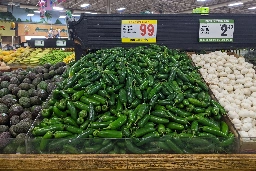
- You've heard of lab grown meat, are you ready for rice-grown beef?www.scimex.org You've heard of lab grown meat, are you ready for rice-grown beef?
You've heard of lab grown meat, are you ready for rice-grown beef? International researchers have developed a beef-rice hybrid they say could be a protein-rich food of the future. The team says they took muscle and fat stem cells from cows, and transplanted them into grains of rice - because

- The $10 trillion benefits of overhauling our food systemwww.theverge.com The $10 trillion benefits of overhauling our food system
A new report lays out two very different paths forward.
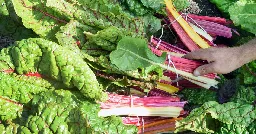
- Cultivated meat production costs could fall significantly: Bovine muscle engineered to produce their own growth signalsphys.org Cultivated meat production costs could fall significantly: Bovine muscle engineered to produce their own growth signals
Cellular agriculture—the production of meat from cells grown in bioreactors rather than harvested from farm animals—is taking leaps in technology that are making it a more viable option for the food industry. One such leap has now been made at the Tufts University Center for Cellular Agriculture (TU...

- The Unending Quest To Build A Better Chicken | NOEMAwww.noemamag.com The Unending Quest To Build A Better Chicken | NOEMA
Maybe what we need is not just a new form of poultry farming but a complete revolution in how we relate to meat.

- Cardiometabolic Effects of Omnivorous vs Vegan Diets in Identical Twins: A Randomized Clinical Trialwww.ncbi.nlm.nih.gov Cardiometabolic Effects of Omnivorous vs Vegan Diets in Identical Twins: A Randomized Clinical Trial
What are the cardiometabolic effects of a healthy plant-based (vegan) vs a healthy omnivorous diet among identical twins during an 8-week intervention?In this randomized clinical trial of 22 healthy, adult, identical twin pairs, those consuming a healthy ...

- The tiny Italian town that drinks like Ancient Rome and Greecewww.bbc.com The tiny Italian town that drinks like Ancient Rome and Greece
Arquà Petrarca is known as the final resting place of a Renaissance patriarch – and the source of a fabled liquor whose name means "to live in bliss", made from the jujube fruit.

- Tuna species popular in sashimi and poke bowls in sharp decline in the Indian Oceanphys.org Tuna species popular in sashimi and poke bowls in sharp decline in the Indian Ocean
The yellowfin tuna commonly enjoyed in sashimi, poke bowls and salad sandwiches may soon disappear from these dishes if current over-exploitation rates remain unchanged, especially in the Indian Ocean.
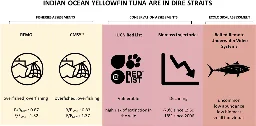
- Just How Healthy Is Salmon?www.nytimes.com Just How Healthy Is Salmon?
Experts explain why it’s such a nutritional powerhouse and if all varieties are created equal.

- Total Meat Intake is Associated with Life Expectancy: A Cross-Sectional Data Analysis of 175 Contemporary Populationswww.ncbi.nlm.nih.gov Total Meat Intake is Associated with Life Expectancy: A Cross-Sectional Data Analysis of 175 Contemporary Populations
The association between a plant-based diet (vegetarianism) and extended life span is increasingly criticised since it may be based on the lack of representative data and insufficient removal of confounders such as lifestyles.We examined the association ...

- What Makes Cheddar Cheese Taste So Good?www.smithsonianmag.com What Makes Cheddar Cheese Taste So Good?
After a year-long cheddar-making experiment, scientists have unraveled the microbial underpinnings of the cheese's buttery flavor

- Ancient Bread, How Did They Make It? Part I: Farmers!acoup.blog Collections: Bread, How Did They Make It? Part I: Farmers!
Thanks to our helpful volunteer narrator, this entire post series is now also available in audio format! This essay will hopefully be the first post in a series (II, III, IV, A) covering some of th…

- ‘People eat two or three packets a day’: how instant noodles took over the worldwww.theguardian.com ‘People eat two or three packets a day’: how instant noodles took over the world
High-salt, processed noodles have become a favourite cheap meal, especially in developing countries, but nutritionists warn of the health costs
